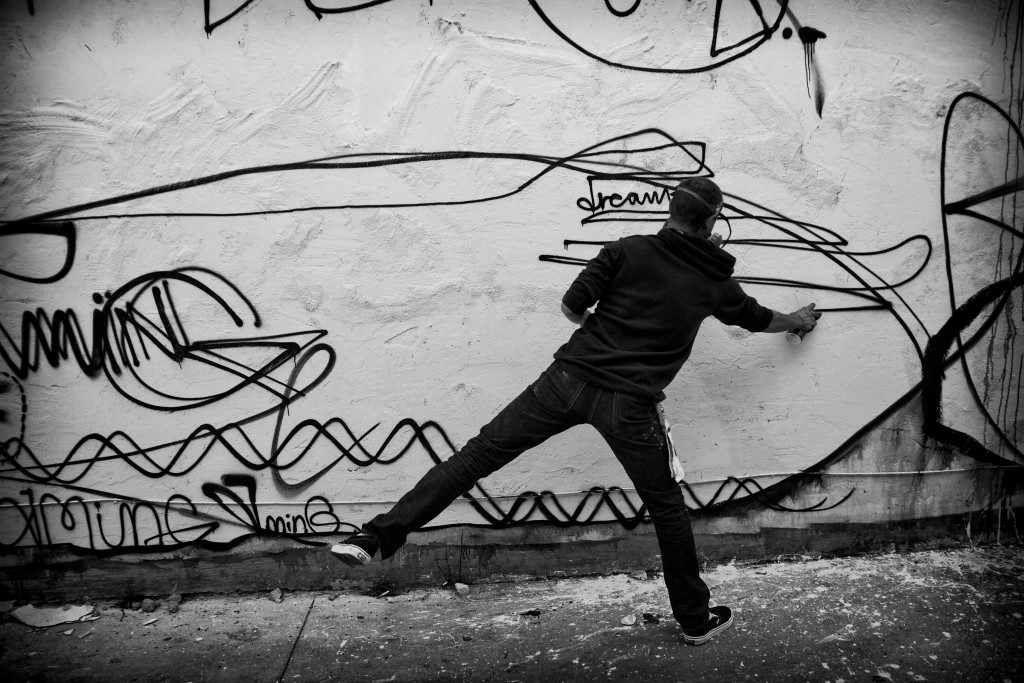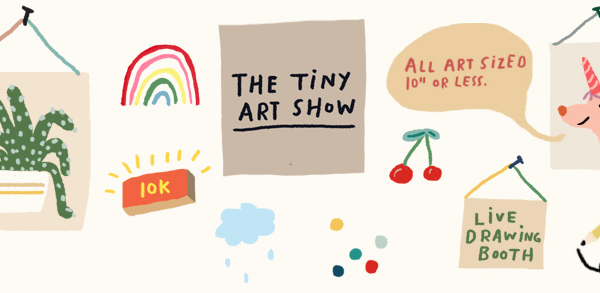Jonathan Matas, 28, an artist based out of San Francisco, recently joined the Living Walls team for a marathon 24-hour mural frenzy. On the way to New York from Florida, Matas came through Atlanta with family who happen to know Monica Campana, co-founder and executive director of Living Walls.
At the time, Matas was only planning on staying in Atlanta for one night, just long enough to see the city and catch a flight to New York, where he was due to begin a series of commissioned pieces. However, the Ukrainian painting team Interesni Kazki was in town working on their mural in East Atlanta and Matas being a huge fan of the duo, decided to stay. A couple of beers later and Matas had his own wall to transform.
Since Matas only extended his Atlantan adventures for another day, he had less than 24 hours to come up with a concept, get supplies and execute his ideas. None-the-less, seven hours after he began, at midnight, Matas had created an incredibly complex and beautiful black-and-white mural.
Here, he talks to CommonCreativ about how he got interested in painting, what street art is and having only 24 hours to finish his wall on the side of Noni’s at Edgewood Ave.
CommonCreativ: How did you first become interested in painting and, more specifically, in street art. Was it a natural progression or was it a goal from the beginning?
Jonathan Matas: I have been painting all my life. Like all kids, I made art, but I kept on going, nonstop. It has always been my passion. The only time in my life that I stopped was last year for about six months, that was an excellent break and I came back with renewed energy and focus.
I got into graffiti around 1999. I don’t remember the term “street art” being used much. It was just straight up graffiti… tags, throw-ups, pieces, streets, freights… I started to notice the graffiti around my neighborhood in Seattle. I switched high schools in 10th grade to the NOVA Project (an alternative high school in Seattle’s Central District), where I started meeting writers from all parts of the city. Not only writers, but breakdancers, MC’s, skaters, etc.
I was really influenced by my friend Bhiver, who I met at NOVA. He passed away in 2007. He was a creative genius. We met each other and were both like “You’re tight!” The pieces he was doing at 17 years old were way more advanced than
anybody our age. I learned a lot about graffiti and creativity in general from him. He just lived and breathed pure, raw creative energy. Being around him was always really intense and hilarious. He played with everything: letters, language, walking, speaking. He was so multi-talented and got REALLY good at whatever he engaged, be it graffiti, printmaking, breakdancing, surfing, standup comedy, etc. I think anybody who knew him would agree that by losing him at such a young age, we lost one of the most naturally talented artists in the world.
CC: Is there anything specific that makes you really passionate about street art? Or anything you really dislike?
JM: On the term “street art” – I don’t even know what it means anymore. I don’t really like being deemed a street artist. I find it self-limiting. I think we humans have a tendency to box ourselves in when we think we’ve found our little niche. I am a painter, a performer and an overall creative person who works everywhere: on the street, in my studio, in bars, clubs, restaurants, preschools, marches, rallies.
Also, since street art is so trendy today, we see a lot of people who put up a few stickers or posters and then have shows as “street artists.” There are so many books and blogs filled with this half-assed “street art” by people who have not paid dues. I come from a school of graffiti bombers that see so-called “street artists” getting attention in an ever-increasing amount of new books and blogs without first paying dues and honing their craft. Some of them hate “street art” and will paint over it at the drop of a hat.
All this being said, I love graffiti. My level of artistic energy is perfectly suitable for a bomber. I quickly became an addict. Even though I’m not a bomber anymore, that frenetic kinesthetic energy flows though a lot of my work (the Atlanta piece, for example). I love climbing, making art wrap around corners and in hard to reach places, moving my whole body while I paint. In many ways, graffiti is great boot-camp for getting into other art forms and it’s exciting to see so many of us getting into legitimate creative careers and seeing how this training and aesthetics are influencing our work. It’s new terrain and really exciting. Sign painters, muralists, tattoo artists, app-developers, designers, fashion designers, etc. One thing that I am doing that is exploring new territory is my performance art/live art.
CC: With the mural you did for Living Walls, you had less than 24 hours to come up with a theme and execute it. Have you ever done something like that before? Did you like the challenge? How does it differ from something like what you did in NYC, which you had plenty of time to prepare for?
JM: I would say I had far less than 24 hours. I didn’t know what I was going to do until I started painting… and then I still didn’t know what I was going to do! Sometimes I come up with an idea and execute it, but rarely. I almost always
work without a clear plan or goal. It comes from a conscious decision to engage art-making as a meditative practice. I enter into a project with an open mind and complete trust in myself as an artist. Working intuitively, with complete trust in myself, has been an incredibly helpful practice in all areas of my life. Through habituation, I have learned to be quite flexible in problem-solving and flowing with the way things are, not the way I planned them to be.
It was the same for the wall in NYC. Even though I knew I’d be painting it, I came up with the concept a few minutes before beginning and then free-styled.
CC: When you’re coming up with and focusing on themes for pieces, especially like the piece you did here in ATL, how do you clear your mind? Do you have any little rituals that help you focus or do you just jump in and hope for the best?
JM: Engaging art as a meditation practice, I always say a little prayer or aspiration before beginning a piece and also before and after each session working on it. This makes the work more intentional. I am always reminding myself of my intentions and what I’d like to accomplish. After the ritual, I just jump in completely.
CC: I know one of the things that got you really excited about Living Walls and Atlanta was that Interesni Kazki happened to be in town when you were coming through. You mentioned that you don’t tend to have “favorite” artists very often, but if you had to name one they would be at the top of the list. What is it exactly, if you can put your finger on it, that interests you about them so much?
JM: Their work has depth to it. It is visually-beautiful and also conceptually-engaging. You can tell that they care deeply about what they are putting out there, and there seems to be very little ego in it, which is incredibly rare today. The work is deeply spiritual and I can relate to that.
CC: Probably the thing I like most about your work is your attention to abstract detail. Is this something you plan and can see clearly in your mind before you begin painting or is it something you free hand? How do you know when you’re done?
JM: I’m definitley not able to see the completed image in my head before beginning. I have a naturally-occurring tendency toward detail. I enjoy art that can sink in over time, with many layers of meaning and depth to explore. For example, from a distance or up close, or the whole piece as a macrocosm containing microcosmic worlds.
As any artist will tell you, knowing when to stop is difficult. All projects are different. Usually, when I arrive at a point when I’m looking for stuff to add rather than doing what jumps out as needing doing, it is time to stop. If you go further, it is acting out of impulsivity or even greed. Intuitively knowing it’s time to stop but continuing is madness. There are no clear dogmatic rules to this though.









bkpr
I used to drive Jonathan and Matt (BHIVER) out to the Seattle free-walls so they could paint without getting arrested! It was a fantastic experience! Such amazing creative energy! Thanks for posting such a insightful article about Jonathan and Living Walls. BHIVER’s dad, bkpr
Seattle